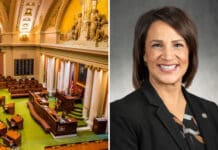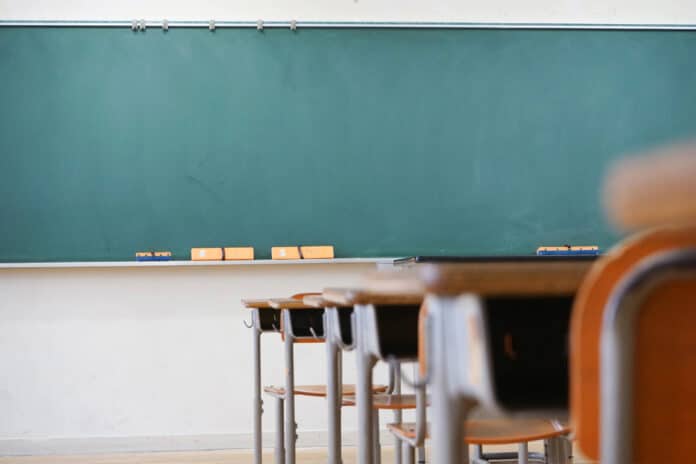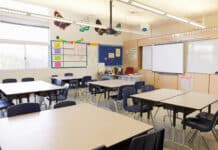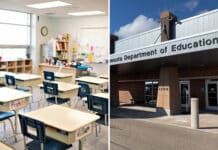(Opportunity for All Kids) — We entrust our education system to teach and prepare future generations of Minnesotans to become successful adults. That’s an incredible responsibility and in the past, the education system performed admirably.
Unfortunately, students today are trapped in a system that has thoroughly broken down. For the second year in a row, less than half (49.9%) of all public school students are proficient in reading.
One year with an incredibly low reading proficiency rate could be seen as an anomaly if it’s followed by a significant upward trend. But there is no upward trend for Minnesota.
In 2023, 50.1% of students struggled to read. In 2024, 50.1% of students also struggled to read. Worse, the downward trend started well before COVID, which is often used by teachers’ unions as the scapegoat.
Below is a trend line of reading and math proficiency from 2019 to 2024.

As you can see, Minnesota’s public education system was not performing prior to COVID. In 2019, only 59% of students were proficient in reading while only 55% were proficient in math.
COVID caused a 10-point drop, but it was not the cause of the systemic breakdown of public education, despite being used as an excuse by those in power.
Here are the top-line results for each grade level in 2024.

Just as in 2023, only 50% of students are proficient in reading for their grade.
In third grade, a critical year for learning, only 47% of students are proficient. Eighth-grade proficiency rates were even worse with only 45% of students proficient in reading. And tenth grade saw the same depressing rate of reading proficiency: 52%.
As for math, the education system seems incapable of teaching the subject to students in grade five or higher. By 11th grade, only 35% of students are proficient in math.
When we look at the proficiency rates by race, we see an even more disastrous story.

Less than a third of Black, Hispanic, and American Indian students are proficient in reading. In other words, over 66% of students representing those communities are struggling to read. While White reading proficiency rates are higher, 42% of those students are struggling to read.
We are now facing a heart-breaking crisis that no amount of money or tinkering can fix.
Education spending
In the last biennium, the state spent $20.2 billion on E-12 education, which was nearly 40% of the budget and the largest portion.
When property taxes and other revenue are added to the state’s funds, many school districts are spending $20,000 or more per student. Some are spending $30,000 or more per student per year.
At $20,000 per student per year, a class of 25 students costs $500,000. Even if a teacher makes $100,000 per year, where does the other $400,000 go?
It’s clear there is more than enough money going to education that teachers shouldn’t be buying school supplies and students should be getting a very good education.
Path #1: Reform the existing education system
As for fixing the system, we’ve been on this trajectory for nearly a decade with COVID accelerating the breakdown—though some would argue the warning signs were there for decades.
Assuming the system can be fixed, how long do you think that will take? 5 years? 10 years? 12 years? How many students are we willing to sacrifice to a failing education system during that period?
Currently, there are roughly 870,000 students in public schools. At least 435,000 young Minnesotans are struggling to read and even more struggle with math.
If we recognize the system has failed and needs a redesign, then isn’t it unjust to keep students trapped in it? Are you okay with 435,000 Minnesota students never receiving the education they need to succeed as adults?
These are all questions warranting serious thought, but there is a greater challenge to change.
The same people, organizations, and teachers’ unions responsible for the failures of the system are those who are in near-total political and cultural control of it.
If education reformers actually had control of public education—and evidence shows their proposed changes are already working in other areas—then it is all but certain we would not be seeing a 49.9% reading proficiency rate in Minnesota.
So, how will reformers change the system when they do not have control of it? That is not meant to be a dig, but a sincere question.
To change the system, you must have control of the system. Getting control of a system, from top to bottom—one that seems to exist for itself rather than the students—is an enormous proposition.
And, sadly, tinkering around the edges will not fix a 49.9% reading proficiency rate.
Because of the many mandates and rules levied on public schools, it makes any change very difficult at the local level of schools and school districts. The only way to reform the system is to be in political and financial control from top to bottom.
Since the problems started over a decade ago, reformers will likely need to undo at least a decade of mandates, regulations, training, and institutional inertia at schools, districts, colleges of education, certification organizations, and government bureaucracies.
How do education reformers do it? How do you get control of the system? And once you have control, how then do you achieve political unity in the proposed changes?
If there isn’t unity, or at least a significant majority who agree on the education policy changes to make and how to implement them, then the system is simply going to continue not serving students, families, and the public while consuming enormous sums of taxpayer dollars.
As divided as we are on political and cultural lines, is that unity possible?
And, again, is it fair to expect parents to continue sending their children into an education system in which 50% of its students struggle to read?
Path #2: School choice and ESAs
Thankfully, there is an alternative that can immediately help students escape from failing schools while also improving schools in the public education system: School choice with Education Savings Accounts (ESAs).
The adage, “Whoever holds the gold, makes the rules” applies to our situation.
The education system has a monopoly on education as 1) children are required to have an education, 2) education costs money, 3) most parents don’t have the money to pay or homeschool, and 4) the state and local governments fund the system while making it “free” to the public.
There is no competition or change within a system that is controlled by its own creators who “hold the gold” through political power. As long as the billions continue to flow to the education system, it will remain as is.
If you really want to greatly improve education, the only way is to change who “holds the gold.” And the best way to do that is to put parents in charge of choosing the best schools for their kids.
Nearly 20 states, like Iowa to our south, have already made the decision and established school choice with ESAs. Many more states, such as Texas, are expected to follow in the upcoming year.
The good news is that 75% of Minnesota parents want that change, too, and nearly 70% of the Minnesota public supports them.

How school choice and ESAs work
Currently, the state allots roughly $7,000 per student per year for education, which is on par with many other states. That $7,000 “follows” the student to a public school or one of the high-demand charter schools that often have wait-lists and lotteries to attend.
With school choice and ESAs, a new system of funding is created for the education of the public that brings accountability, a diversity of approaches, and the freedom and resources for families to find the best schools for their kids.
If passed, proposed Education Savings Account (ESA) legislation would work very much like a Health Savings Account (HSA), except instead of the funds coming from the employee or employer, the funds would come from the state.
With universal school choice, each K-12 student in Minnesota would be eligible to establish an ESA in their name through the state. The state would then deposit the already allotted $7,000 for them into their accounts. The family or guardians would receive a debit card assigned to each of their students’ Education Savings Accounts (ESA). That debit card can only be used on eligible expenses, which include tuition at any public, charter, or private school as well as tutoring, curriculum, and extra-curricular activities.
Simply put, the $7,000 allotted to the student by the state is now directed to the best educational option by the parents or guardians. Parents now “hold the gold” without an enormous, endless political battle over the purse and education policy for the entire state.
Schools—be they what we currently consider public, charter, or private—that earn a reputation for educational excellence and best match the values or culture of families will be rewarded with an influx of students who now can afford to attend. Schools that are falling behind will need to improve or see their funding dwindle away.
In a public education system founded on choice and parental power, all educators and administrators are positively motivated to excel at the mission of educating the next generation of Minnesotans.
As it stands now, failure is rewarded. Indeed, the current system often receives budget increases while proficiency rates decline. The solution, we are told, by those in control of the system is almost always “more money.”
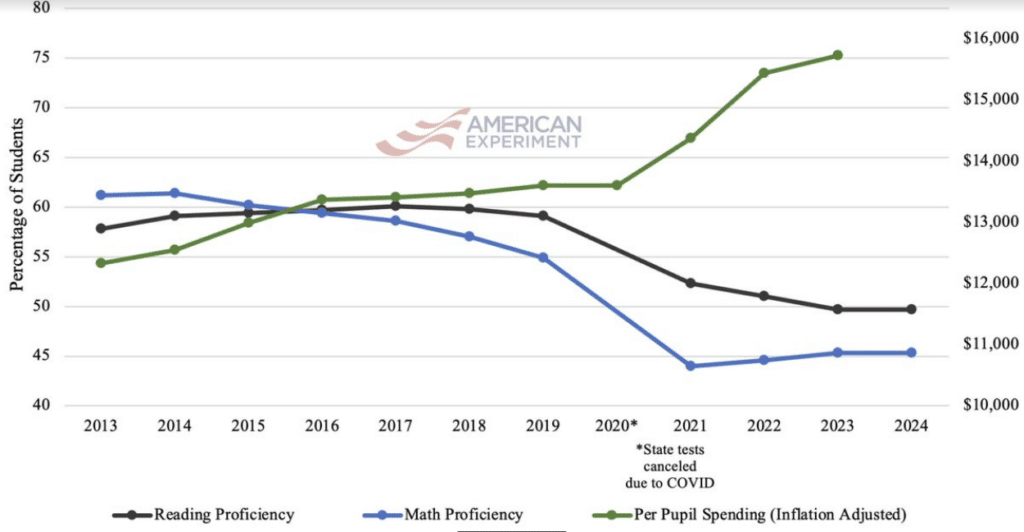
As you can see from the chart above from Center of the American Experiment, more money does not equal better education.
Which path, Minnesota?
Minnesota must confront the painful truth that our once-phenomenal education system has collapsed over the last decade with COVID merely accelerating the demise.
If you want change, if you want to see reading and math proficiency at rates that were once considered normal, you have two choices:
- Long-running, brutal political and cultural battles to gain control of the education system from top to bottom.
- A new public education funding system that puts parents in charge of the purse, giving them the freedom and resources to find the best schools for their kids.
As divided as our nation and state are, which do you think is most likely to succeed?
Remember, 75% of Minnesota parents and nearly 70% of the public support the second option of school choice with Education Savings Accounts.
This article was originally published at Opportunity for All Kids.
The views and opinions expressed in this commentary are those of the author and do not represent an official position of Alpha News.




